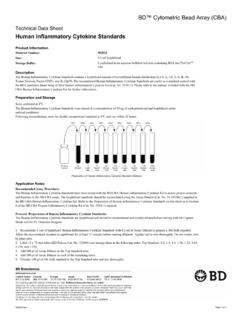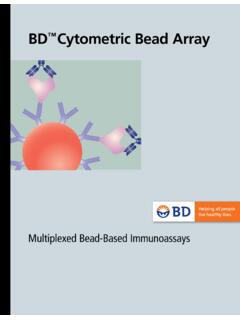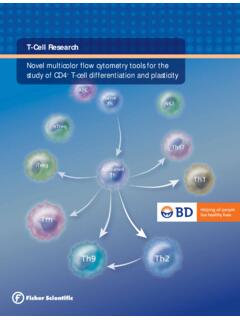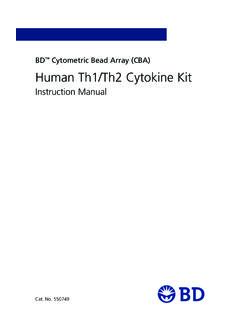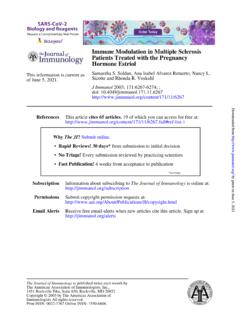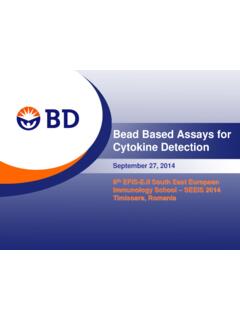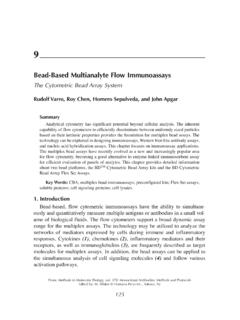Transcription of Feasibility of a Multiplex Flow Cytometric Bead ...
1 CLINICAL ANDVACCINEIMMUNOLOGY, Sept. 2007, p. 1165 1172 Vol. 14, No. 91556-6811/07/$ 0 2007, American Society for Microbiology. All Rights of a Multiplex Flow Cytometric Bead immunoassay forDetection of Anti-Epoetin Alfa Antibodies John Ferbas,1* John Thomas,1 John Hodgson,2 Amitabh Gaur,2 Nicole Casadevall,3and Steven J. Swanson1 Amgen, Inc., Thousand Oaks, California1; BD Biosciences, San Diego, California2; and Ho pital de l Ho tel-Dieu,Service d He matologie Biologique, Paris, France3 Received 11 April 2007/Returned for modification 18 May 2007/Accepted 5 July 2007 Immunogenicity profiles of recombinant therapeutic proteins are important to understand because anti-bodies raised against these molecules may have important clinical sequelae.
2 The purpose of the present studywas to demonstrate that a flow Cytometric bead array could be used to detect clinically relevant antibodies withspecificity to such therapeutics. We chose to evaluate well-characterized specimens from persons treated withepoetin alfa that developed antibody-mediated pure red blood cell aplasia as a means to demonstrate the utilityof this platform. Our data show that this assay is capable of detecting anti-epoetin alfa antibodies with arelative antibody concentration of 50 ng/ml, where 25 of 25 sera spiked with antibodies at this concentrationscored positive. Moreover, the assay was designed to include positive and negative control beads for eachspecimen that is processed to ensure the specificity of the signal when detected.
3 Measurement of interassayprecision supports quantitative estimates of relative antibody concentrations in the range of 313 to 5,000 ng/ml,where the percent coefficient of variation did not exceed 20%. With respect to clinical specimens, antibodieswith specificity for epoetin alfa could be easily detected in a set of specimens from persons with pure red bloodcell aplasia that had prior exposure to the EPREX brand of recombinant epoetin alfa. Further developmentand validation of this approach may facilitate successful widespread application of the method for detection ofanti-epoetin alfa antibodies, as well as antibodies directed against other recombinant therapeutic responses that occur in vivo during administrationof a therapeutic protein can induce clinically significant ad-verse events, including neutralization of both the therapeuticand its endogenous counterpart.
4 Although all antibody iso-types may have this property, manifestations appear to emergeafter the class switch to the immunoglobulin G (IgG) isotype(11, 17). Clinical management of persons with antibody-neu-tralized endogenous proteins is not straightforward and mostcommonly involves the cessation of (drug) administration withsupportive care on a case-by-case basis until the circulatingconcentration of antibodies decreases to nonpathological lev-els (1). The prolonged half-life of antibodies and plasma cellsmakes this a long-term issue for the prototypical example of the ability of a recombinant ther-apeutic protein to raise cross-reactive, neutralizing antibodiesis provided by patients that developed antibody-mediated purered blood cell aplasia during treatment with recombinant epo-etin alfa manufactured and sold outside of the United protein was linked to the induction of neutralizing IgGantibodies and the development of pure red cell aplasia(PRCA) in more than 200 patients since 1998 (1)
5 , with themajority of cases attributed to the EPREX brand of recombi-nant epoetin alfa. Even though the manufacturer of EPREXhas since taken action to potentially remediate this situation (3,4), there is no consensus that the problem has in fact beensolved (19, 21). Moreover, the emergence of biosimilar thera-peutics has been considered by some to increase the odds thata clinically significant immunogenicity issue will occur in thefuture (6, 13).Currently, each drug manufacturer is responsible for inter-nal development and execution of antibody detection and sur-veillance programs. The assays that are offered vary widely (12,24), each with individual performance characteristics (22), andthere is no formal certification program to ensure that a givenassay is suitable for clinical diagnoses.
6 Despite the longstand-ing commercial success of human recombinant erythropoiesisstimulating proteins, the lack of a standardized clinical assay toprovide a differential diagnosis of this adverse event placespatients at unnecessary clear need for the biotechnology industry to apply ro-bust, harmonized assays in this setting motivated our labora-tory to design a Multiplex immunoassay platform. This ap-proach is gaining popularity in a variety of settings, includingimmunogenicity assessments for persons treated with recom-binant granulocyte colony-stimulating factor (2), new ap-proaches to monitor for vaccine responsiveness in clinical trials(7), and measurement of autoantibodies in the clinic (20).
7 Among the many advantages to multiplexing in this setting, theability to include positive and negative controls in each speci-men that is analyzed may be regarded as a particular strengthof this approach, as illustrated by the experiments presentedhere. It is ultimately envisioned that the Cytometric bead arraycould serve a diagnostic role that could complement moreextensive testing and characterization of the antibody re-sponse, including the formal demonstration of neutralizingpotential in a cell-based assay (26) (by the manufacturer of thetherapeutic agent).* Corresponding author. Mailing address: Department of ClinicalImmunology, Amgen Inc.
8 , One Amgen Center Drive, Mailstop 30E-3-C, Thousand Oaks, CA 91320-1799. Phone: (805) 447-2867. Fax:(805) 480-1306. E-mail: Published ahead of print on 18 July on January 14, 2021 by from MATERIALS AND METHODSS erum from normal donors was purchased from Biorecla-mation, Inc. (Hicksville, NY). Serum from persons who developed PRCA sub-sequent to epoetin alfa therapy was provided to Amgen Clinical ImmunologyLaboratories by Nicole Casadevall (Ho pital de l Ho tel-Dieu, Paris, France);these specimens were collected in compliance with institutional policies and hadbeen previously characterized in a variety of cell-based and immunoassay plat-forms (5, 19).
9 All specimens were stored frozen at 20 C until of beads and serum samples for Cytometric bead (Becton Dickinson) of distinct and nonoverlapping fluorescence emissionintensities were covalently coupled with epoetin alfa (Amgen, Inc., ThousandOaks, CA), sperm whale myoglobin (Sigma-Aldrich, St. Louis, MO), or humanIgG (Becton Dickinson) via standard amine chemistry (10). A fourth blank bead was left unconjugated and served as a reference negative control bead (inaddition to the sperm whale myoglobin bead). The beads were identical to thoseused in the commercially available Cytometric bead array assays marketed byBecton Dickinson and are hard dyed with a water-insoluble dye that is excited bythe 488-nm laser source (with emission at 576 nm).
10 To perform the assay, beadswere vortexed vigorously, and then 15 l of each of the four bead types wascombined to comprise the bead master mixture, 50 l of which was added to eachmultiplex assay assay was set up as depicted in Fig. 1 and followed the commerciallyavailable Cytometric bead array platform protocol (16). Briefly, 50 l of beadmixture was combined with 50 l of serum (diluted to a 1% [vol/vol] concentra-tion), vortexed, and then incubated for h at room temperature. Samples werewashed by the addition of 1 ml of wash buffer and then centrifuged at 200 gfor5 min. The supernatant was aspirated, and then 50 l of phycoerythrin detectionreagent was added to each tube, vortexed, and then incubated for 30 min at roomtemperature.
